![]()
![]()
![]()
Use LEFT and RIGHT arrow keys to navigate between flashcards;
Use UP and DOWN arrow keys to flip the card;
H to show hint;
A reads text to speech;
11 Cards in this Set
- Front
- Back
|
what class and order are mites in. what significance does this have.
|
CLASS- arachnida
ORDER-acarina includes ticks and mites. 4 pairs of legs / a cephalo-thorax and Ab/modified mouth/no wings |
|
|
describe the general epideniology of mites, their general pathology and size.
|
pernament ectoparasites so rely on contact to transmit . however a population can build up from a single female.
cause mange which is severe dermatitis. MORPHOLOGY- small ( <0.5mm) |
|
|
name all the familes and their genera and species which are burrowing mites and the sp they are significant in.
|
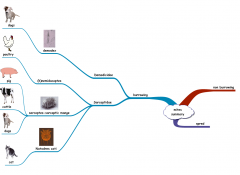
Sarcoptidae ( sarcoptes scabiei in pig, cattle and dog / notoedres cati in cat/ knemidocoptes in poultry )
demodicidae - demodex ( dogs only) |
|
|
sarcoptes is a burrowing mite in the family sarcoptidae. which species of sarcoptes is significant and who can it infect. how is it ID from other mites and what clinical signs and pathology does it cause. how is it diagnosed. how is it treated.
|
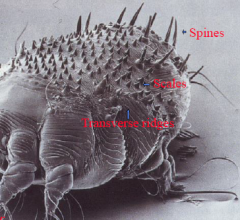
there is only 1 sp sarcoptes scabiei.
infects all domestic mammals and man with strong adaption to their particular host. ( significant in dog, cattle and pig) PATHOLOGY -causes sarcoptic mange - severe dermatitis with severe PRURITUS as well. caused by burrowing and feeding and made worse by hypersensitivity to mite alergens. also highly contagious. also self trauma due to scratch reflex within a week of the primary infection before lesions are visible. CLINICAL SIGHS- erythema/papules/excorination- may lead to secondary inf./alopecia/crust. may spred all over- weak and thin with strong odour. differentiared due to its transverse ridges, spines and scales on its dorsal surface. DIAGNOSIS- Skin scarpping or ELISA TREATMENT-Bath weekly in acaricide (amitraz) for 4 weeks or longer/Selamectin as a spot on/Moxidectin/Imidacloprid as a spot on /Isolate cases and treat all dogs in group /Corticosteroid treatment |
|
|
describe the lifecycle of sarcoptes scabiei beginning with the transmittion
|
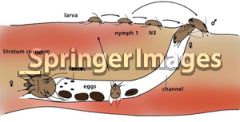
Transmission is probably via the larvae on the surface of the skin- highly contagious . the total time is 2-3 weeks.
before laying eggs the fertilised female will burrow into the surface layers of the skin making a winding tunnel. it will lay 1-3 eggs per day over a 2 month peiord/ hatch to larvae ( around 5 days) /larvae travel to the skins surface and form moulting pockets- moult to nymph and then adult- male seeks out female on surface or in pocket . |
|
|
with sarcoptes scabiei of the dog , cattle and pig where is the primary lesion usually found
|
dog- ears ( edges of ears are often 1st)/face/muzzle/elbows
cattle- neck and tail perfered pigs- common in ears |
|
|
describe sarcoptes scabiei infection outcome in cattle and the treatment.
|
prefers neck and tail.
usually mild ( scale ) but potentially severe ( hair loss and thick skin and crusts and pruritis . TREATMENT-single injection of ivermectin |
|
|
describe infection with sarcoptes scabiei of pigs. signs, transmission and control and treatment
|
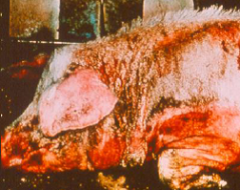
common but often asymptomatic.
Transmission during suckling. Ears are common site of infestation. Red papules and erythema: eyes, snout, ears. Pruritis - Continuous scratching-lose condition. Causes excoriation and Scab formation. Wrinkled, thickened skin covered with crusty lesions. Can treat/control with Doramectin (Dectomax) |
|
|
notoedres cati is a burrowing mite in the family sarcoptidae. where does it usually begin and spred to and where does it occur, what do the lesions look like and is it pruritic. what are the 3 ways it can be differentiated from sarcoptes scabiei and how is it treated
|
Lesion on ear edge-Spread over ears, face and neck
Dry encrusted lesions/thickened leathery skin Intense pruritis & severe excoriation Occurs in nests - highly contagious MORPHOLOGY DIFFERENT FROM SARCOPTES SCABIEI... 1. smaller 2. lacks spines and scales 3. has unique thumb prin striations treat with ivermectin or selamectin |
|
|
knem-ido-coptes is a burrowing mite. what species does it infect. what family is it in and what are the significant sp of knemidocoptes and why.
|
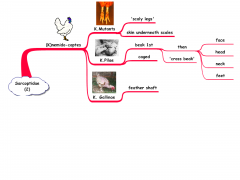
domestic birds ( IMP in poultry and caged birds)
also the sarcoptidae family. knemidocoptes gallinae - burrows into the feather shaft- pain /irritation and feather loss ( 'galli 'gosh he is bald! knemidocoptes pilae - beak 1st then face, neck, head, and feat.- caged birds. knemidocoptes mutans - causes scaly leg by attacking the skin below the scales.( 'Mutated' legs!!) |
|
|
what family is the genera demodex in and what sp of demodex is of significance. what is different about this burrowing mite. how is it diagnosed and what is its morphology. how is it transmitted. what is its pathology. how to treat.
|
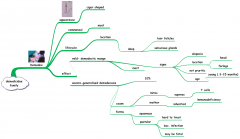
in the family demodicidae and demodex canis is the only significant sp.
it is a commensal of most mammals ( lives in sebaceous glands and hair follicles ) DIAGNOSIS- DEEP skin scraping. cigar shape with 4 stumpy legs. TRANSMITTED- needs prolonged contact. pups usually get it when nursing. PATHOLOGY- most get mild mange ( dermatitis ) with a slight alopecia and thickening of the skin ,usually non pruritic and localized and resolves without treatment. seen in young ( 3-15 m ) location is usually the head or forlegs. In about 10% you will see severe generalised demodecosis with 2 forms ( squamous and pustular ) squamous - alopecia, thickening of skin. or pustular- bac invasion, pus, erythema and hyperpigmentation ( red mange), hard to treat. very debilitating. TREATMENT- Repeated treatment with acaricide (amitraz)/Plus antibiotics/Moxidectin or Imidacloprid spot on (Advocate) 2-4 treatments /Takes at least 3 months and remission not guaranteed |

